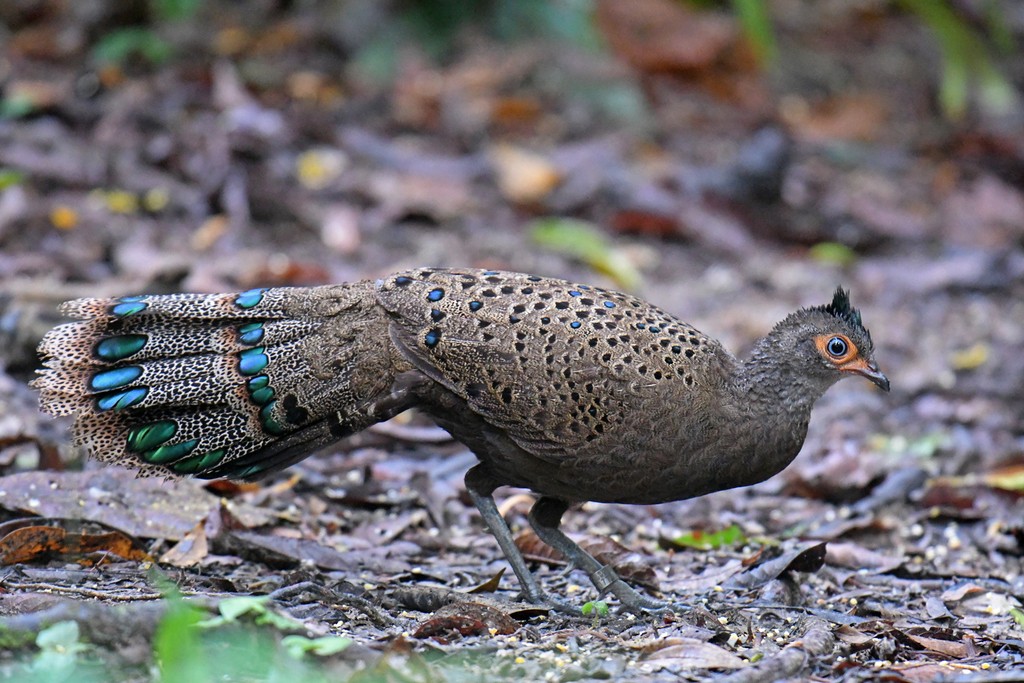Malayan Peacock-pheasant
A species of Peacock-pheasants Scientific name : Polyplectron malacense Genus : Peacock-pheasants
Malayan Peacock-pheasant, A species of Peacock-pheasants
Botanical name: Polyplectron malacense
Genus: Peacock-pheasants
Content
Description General Info
 Photo By wengchun , used under CC-BY-NC-4.0 /Cropped and compressed from original
Photo By wengchun , used under CC-BY-NC-4.0 /Cropped and compressed from original Description
It is one of the shortest-tailed peacock-pheasants. Adult males are about 50 cm long, about half of which is made up by the tail. Their tarsus measures approximately 6.5 cm, and their wings are 20–21 cm long; they weigh from over 600 to nearly 700 g. Their plumage is generally pale brown with small black spots and bands all over, creating the "salt-and-pepper" effect found in most peacock-pheasants. It has iridescent blue-green eyespots with a buff border on its upperwings, back, and on the 22 rectrices, a white throat running down to the center of the breast, and a loose, pointed and upturned dark blue-green crest on its forehead. A bare facial skin surrounds the eyes with their bluish-white iris; usually pink, it becomes bright orange-red during courtship. The bill and legs are blackish. The female is slightly smaller than the male, with a noticeably shorter tail; measuring about 40 cm overall, its tail is slightly less than 20 cm long, while its tarsus measures c.6 cm and its wing length is 18 cm. Adult Females weigh about 450-550 g. Their plumage is duller than in males, with a vestigial crest and eyespots only on remiges and rectrices. On the wing coverts and back, they have dark dots instead, which are pointed towards the feather tip. Young birds resemble females but have even less-developed eyespots and usually lack them entirely except on the rectrices. The downy hatchlings are pale chestnut-brown above and buff below. 
Size
53 cm
Nest Placement
Ground
Feeding Habits
Malayan Peacock-pheasant follows an opportunistic diet, consuming insects like grasshoppers and ants, various fruits, moss, and plant matter, foraging by scratching leaf litter and pecking at low-flying insects.
Habitat
The habitat of malayan Peacock-pheasant primarily consists of evergreen rainforests on flat or gently undulating terrain, usually in lowland areas. These forests are characterized by towering dipterocarp trees and a dense understorey replete with small palms, particularly from the Iguanura and Pinanga genera. Malayan Peacock-pheasant have an affinity for moist environments, often being found in proximity to streams. Their presence in secondary forests suggests some flexibility, although their ability to endure habitat modification seems limited.
Dite type
Omnivorous
General Info
Feeding Habits
Bird food type
Species Status
Due to ongoing habitat loss, small population size and limited range, the Malayan peacock-pheasant is evaluated as Vulnerable on the IUCN Red List of Threatened Species. Its classification is VU A2cd+3 cd+4 cd, meaning that its numbers have declined about two-thirds in the last decade or so, and that this trend is expected to last for another decade at least. It is listed on CITES Appendix II. Deforestation is the main threat for this species, and has rendered more than half of the places where it was found in the 1970s unsuitable for it. The available habitat has even declined by over three-quarters during that time, indicating that the population – estimated at about 8,000 adults as of 2008 – is close to the maximum possible, as less and less suitable forest is not inhabited by P. malacense. It used to be hunted for food or as a trophy, but compared to deforestation these threats are nearly insignificant nowadays. While a small amount of selective logging is tolerated by this bird, it depends on sufficient primary forest to persist. Most Malay peacock-pheasants today live in protected areas in Malaysia, namely Taman Negara National Park and Krau Wildlife Reserve in Pahang, and perhaps Sungkai Sambar Deer and Pheasant Wildlife Reserve in Perak and Sungai Dusun Wildlife Reserve in Selangor. There are also a few reports from less strictly-protected areas, such as Pasoh Forest Reserve in Negeri Sembilan. In areas where they receive protection and where suitable habitat is plentiful, the Malay peacock-pheasant can be fairly common, and thus become a flagship species for ecotourism and other forms of sustainable development. A zoo population exists, numbering 189 birds in 35 sites in 1993. Its studbook is maintained by the New York Zoological Society and Wildlife Conservation International. The Department of Wildlife and National Parks of Malaysia is preparing a captive breeding program to bolster the population in reserves and prevent inbreeding depression by release of captive-bred birds. 
Scientific Classification
Phylum
Chordates Class
Birds Family
Phasianidae Genus
Peacock-pheasants Species
Malayan Peacock-pheasant